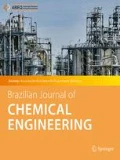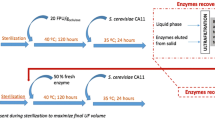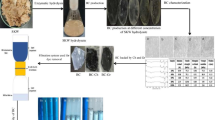Abstract
The enzymatic hydrolysis of residual cellulose casings from sausage processing was assessed. A central composite design (CCD) was performed to determine the best enzyme and substrate concentrations to release reducing sugars (RS) using the enzymatic complex Celluclast. The optimal response found in the CCD was a substrate concentration of 34.1 mg/mL and enzyme concentration of 1:200 (v:v). The combination two enzymatic preparations, Celluclast and Viscozyme, was evaluated to increase the final concentration of RS. The mixture of Celluclast (75%) and Viscozyme (25%) improved the reaction conversion and the glucose concentration. A substrate conversion of 85% in RS (31 mg/mL) was reached at 25 h, composed of 21 mg/mL of glucose and 10 mg/mL of cellobiose. The reaction was scaled-up 16-fold (from 0.25 to 4 L), and the enzymatic conversion remained constant. Thus, the results found in this work proved to be a good alternative for reusing this industrial waste.
Graphic abstract






Similar content being viewed by others
Abbreviations
- RS:
-
Reducing sugars
- CBHs:
-
Cellobiohydrolases
- EGs:
-
Endoglucanases
- CCD:
-
Central composite design
- CC:
-
Cellulose casings
- RCC:
-
Residual cellulose casings
- RCCW:
-
Washed residual cellulose casings
- FP:
-
Filter paper
- DNS:
-
3,5-Dinitrosalicylic acid
- DP:
-
Polymerization degree
- Ki :
-
Enzyme constant of product inhibition
References
Andrić P, Meyer AS, Jensen PA, Dam-Johansen K (2010) Effect and modeling of glucose inhibition and in situ glucose removal during enzymatic hydrolysis of pretreated wheat straw. Appl Biochem Biotechnol 160(1):280–297. https://doi.org/10.1007/s12010-008-8512-9
Annamalai N, Nallusamy S, Piotr O-P (2018) Enhanced production of microbial lipids from waste office paper by the oleaginous yeast cryptococcus curvatus. Fuel 217 (November 2017):420–26. https://doi.org/10.1016/j.fuel.2017.12.108
AOAC (2000) Official methods of analysis of AOAC international. [Gaithersburg, Md.] : AOAC International. https://search.library.wisc.edu/catalog/999794307402121
Arantes V, Saddler J (2010) Access to cellulose limits the efficiency of enzymatic hydrolysis: the role of amorphogenesis. Biotechnol Biofuels 3(1):1–11. https://doi.org/10.1186/1754-6834-3-4
Bansal P, Hall M, Realff MJ, Lee JH, Bommarius AS (2009) Modeling cellulase kinetics on lignocellulosic substrates. Biotechnol Adv. https://doi.org/10.1016/j.biotechadv.2009.06.005
Baramee S, Teeravivattanakit T, Phitsuwan P, Waeonukul R, Pason P, Tachaapaikoon C, Kosugi A, Sakka K, Ratanakhanokchai K (2017) A novel GH6 cellobiohydrolase from paenibacillus curdlanolyticus B-6 and its synergistic action on cellulose degradation. Appl Microbiol Biotechnol 101(3):1175–1188. https://doi.org/10.1007/s00253-016-7895-8
Barbut S (2011) Sausage casings - microstructure of regular and coat ed cellulose, fabric and plastic casings. Italian J Food Sci 23(2):208–213. https://doi.org/10.1016/b978-0-444-53501-6.00006-8
Bommarius AS, Katona A, Cheben SE, Patel AS, Ragauskas AJ, Knudson K, Yunqiao P (2008) Cellulase kinetics as a function of cellulose pretreatment. Metab Eng 10(6):370–381. https://doi.org/10.1016/j.ymben.2008.06.008
Cumba HJ (2005) Production of value-added products from meat processing cellulose waste. Oklahoma State University, Oklahoma
de Damborenea J, Navas C, García JA, Arenas MA, Conde A (2007) Corrosion–Erosion of TiN-PVD coatings in collagen and cellulose meat casing. Surf Coat Technol 201(12):5751–5757. https://doi.org/10.1016/j.surfcoat.2006.10.009
Geankoplis CJ (1998) Procesos de Transporte y Operaciones Unitarias. CECSA. University of Minnesota. Mexico, no. 3: 1024
Gentry JL, Hussein HS, Berger LL, Fahey GC (1996) Spent cellulose casings as potential feed ingredients for ruminants. J Anim Sci 74:663–671
Ghose TK (1987) Measurement of cellulase activities. Pure Appl Chem 59(2):257–268. https://doi.org/10.1351/pac198759020257
Jain A, Wei Y, Tietje A (2016) Biochemical conversion of sugarcane bagasse into bioproducts. Biomass Bioenerg 93:227–242. https://doi.org/10.1016/j.biombioe.2016.07.015
Jalak J, Kurašin M, Teugjas H, Väljamäe P (2012) Endo-exo synergism in cellulose hydrolysis revisited. J Biol Chem 287(34):28802–28815. https://doi.org/10.1074/jbc.M112.381624
Jørgensen H, Vibe-Pedersen J, Larsen J, Felby C (2007) Liquefaction of lignocellulose at high-solids concentrations. Biotechnol Bioeng 96(5):862–870. https://doi.org/10.1002/bit.21115
Kristensen JB, Felby C, Jørgensen H (2009) Yield-determining factors in high-solids enzymatic hydrolysis of lignocellulose. Biotechnol Biofuels 2:1–10. https://doi.org/10.1186/1754-6834-2-11
Kubicek CP, Kubicek EM (2016) Enzymatic deconstruction of plant biomass by fungal enzymes. Curr Opin Chem Biol 35(December):51–57. https://doi.org/10.1016/j.cbpa.2016.08.028
Lier S, Julia R, Gordana C, Anna KL, Stephan M, Sarah P, Laura S, Marcus G (2018) Innovative scaling strategies for a fast development of apparatuses by modular process engineering. Chem Eng Process Process Intensificat 123:111–125. https://doi.org/10.1016/j.cep.2017.10.026
Maitan-Alfenas GP, Visser EM, Guimarães VM (2015) Enzymatic hydrolysis of lignocellulosic biomass: converting food waste in valuable products. Curr Opin Food Sci 1(1):44–49. https://doi.org/10.1016/j.cofs.2014.10.001
Maroušek J, Hašková S, Zeman R, Žák J, Vaníčková R, Maroušková A, Váchal J, Myšková K (2015) Techno-economic assessment of processing the cellulose casings waste. Clean Technol Environ Policy 17(8):2441–2446. https://doi.org/10.1007/s10098-015-0941-x
Miller GL (1959) Use of dinitrosalicylic acid reagent for determination of reducing sugar. Anal Chem 31(3):426–428. https://doi.org/10.1021/ac60147a030
Mirabella N, Castellani V, Sala S (2014) Current options for the valorization of food manufacturing waste: a review. J Clean Product 65(November):28–41. https://doi.org/10.1016/j.jclepro.2013.10.051
Miyamoto H, Yamane C, Seguchi M, Okajima K (2010) Comparison between cellulose blend films prepared from aqueous sodium hydroxide solution and edible films of biopolymers with possible application for new food materials. Food Sci Technol Res 17(1):21–30. https://doi.org/10.3136/fstr.17.21
Mohapatra S, Mishra C, Behera SS, Thatoi H (2017) Application of pretreatment, fermentation and molecular techniques for enhancing bioethanol production from grass biomass? A review. Renew Sustain Energy Rev 78(May):1007–1032. https://doi.org/10.1016/j.rser.2017.05.026
Oh K-K, Kim S-W, Jeong Y-S, Hong S-I (2000) Bioconversion of cellulose into ethanol by nonisothermal simultaneous saccharification and fermentation. Appl Biochem Biotechnol 89(1):15–30. https://doi.org/10.1385/ABAB:89:1:15
Philippidis GP, Smith TK, Wyman CE (1993) Study of the enzymatic hydrolysis of cellulose for production of fuel ethanol by the simultaneous saccharification and fermentation process. Biotechnol Bioeng 41(9):846–853. https://doi.org/10.1002/bit.260410903
Pino MS, Rosa MR-J, Michele M, Adriana CF-G, Ricardo M-R, José AT, Héctor AR (2018) Bioreactor design for enzymatic hydrolysis of biomass under the biorefinery concept. Chem Eng J 347:119–136. https://doi.org/10.1016/j.cej.2018.04.057
Rodrigues AC, Haven MØ, Lindedam J, Felby C, Gama M (2015) Celluclast and Cellic® CTec2: saccharification/fermentation of wheat straw, solid–liquid partition and potential of enzyme recycling by alkaline washing. Enzyme Microbial Technol 79–80(November):70–77. https://doi.org/10.1016/j.enzmictec.2015.06.019
Rust RE, Knipe CL (2014) Sausage casings. Encyclopedia Meat Sci 3:235–240. https://doi.org/10.1016/B978-0-12-384731-7.00137-9
Saini JK, Patel AK, Adsul M, Singhania RR (2016) Cellulase adsorption on lignin: a roadblock for economic hydrolysis of biomass. Renewable Energy 98(December):29–42. https://doi.org/10.1016/j.renene.2016.03.089
Sanders DA, Belyea RL, Taylor TA (2000) Degradation of spent casings with commercial cellulases. Biores Technol 71(2):125–131. https://doi.org/10.1016/S0960-8524(99)00063-2
Savic Z, Savic I (2016) Sausage Casings. Edited by (Victus International GmbH) Savic, Z. 2nd ed. Viena: Victus International GmbH. https://books.google.ca/books?id=_G5fAQAACAAJ
Silveira MH, Luciano RS, Aguiar MS-a, Ramos LP (2014) Assessment of the enzymatic hydrolysis profile of cellulosic substrates based on reducing sugar release. Biores Technol 151:392–396. https://doi.org/10.1016/j.biortech.2013.09.135
Sluiter A, Hames B, Ruiz R, Scarlata C, Sluiter J, Templeton D, Crocker D (2010) NREL/TP-510-42618 - determination of structural carbohydrates and lignin in biomass. Laboratory Analytical Procedure (LAP), no. June
Sreenath HK, Jeffries TW (2011) Interactions of fungi from fermented sausage with regenerated cellulose casings. J Ind Microbiol Biotechnol 38(11):1793–1802. https://doi.org/10.1007/s10295-011-0966-z
Sreenath HK, Koegel RG (2008) Bioconvertion of spent cellulose sausage casings. Enzyme Microbial Technol 43(2):226–232. https://doi.org/10.1016/j.enzmictec.2007.09.005
Srivastava N, Manish S, Mishra PK, Gupta VK, Molina G, Rodriguez-Couto S, Manikanta A, Ramteke PW (2018) Applications of fungal cellulases in biofuel production: advances and limitations. Renew Sustain Energy Rev 82(June 2016):2379–2386. https://doi.org/10.1016/j.rser.2017.08.074
Talebnia F, Karakashev D, Angelidaki I (2010) Production of bioethanol from wheat straw: an overview on pretreatment, hydrolysis and fermentation. Biores Technol 101(13):4744–4753. https://doi.org/10.1016/j.biortech.2009.11.080
Yu X, Liu Y, Cui Y, Cheng Q, Zhang Z, Jia Hui L, Meng Q, Teng L, Ren X (2016) Measurement of filter paper activities of cellulase with microplate-based assay. Saudi J Biol Sci 23(1):S93–S98. https://doi.org/10.1016/j.sjbs.2015.06.018
Zain MM, Mohammad AW, Harun S, Fauzi NA, Hairom NHH (2018) Synergistic effects on process parameters to enhance enzymatic hydrolysis of alkaline oil palm fronds. Ind Crops Prod 122(June):617–626. https://doi.org/10.1016/j.indcrop.2018.06.037
Zhang YHP, Lynd LR (2004) Toward an aggregated understanding of enzymatic hydrolysis of cellulose: noncomplexed cellulase systems. Biotechnol Bioeng 88(7):797–824. https://doi.org/10.1002/bit.20282
Zhang YHP, Himmel ME, Mielenz JR (2006) Outlook for cellulase improvement: screening and selection strategies. Biotechnol Adv 24(5):452–481. https://doi.org/10.1016/j.biotechadv.2006.03.003
Acknowledgments
This work was supported by grants and scholarships from Conselho Nacional de Desenvolvimento Científico e Tecnológico (CNPq), FAPERGS (process 17/2551-0000939-8) and Coordenação de Aperfeiçoamento de Pessoal de Nível Superior—Brasil (CAPES)—Finance Code 001. We also thank the LNF Latino Americana for supplying the enzymes used in this work.
Author information
Authors and Affiliations
Corresponding author
Additional information
Publisher's Note
Springer Nature remains neutral with regard to jurisdictional claims in published maps and institutional affiliations.
Rights and permissions
About this article
Cite this article
Gabiatti Junior, C., Dal Magro, L., Graebin, N.G. et al. Combination of Celluclast and Viscozyme improves enzymatic hydrolysis of residual cellulose casings: process optimization and scale-up. Braz. J. Chem. Eng. 37, 463–473 (2020). https://doi.org/10.1007/s43153-020-00050-w
Received:
Revised:
Accepted:
Published:
Issue Date:
DOI: https://doi.org/10.1007/s43153-020-00050-w




